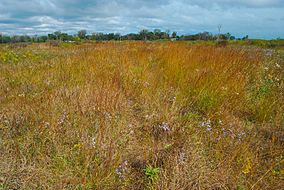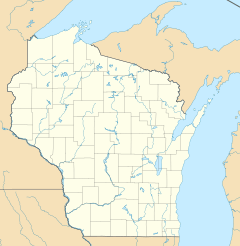Chiwaukee Prairie facts for kids
Quick facts for kids Chiwaukee Prairie |
|
|---|---|

Chiwaukee Prairie, October 2010
|
|
| Location | Kenosha County, Wisconsin |
| Area | 485 acres (196 ha) |
| Designated: | 1973 |
| Official name: Chiwaukee Illinois Beach Lake Plain | |
| Designated: | 25 September 2015 |
| Reference #: | 2243 |
Chiwaukee Prairie is a special natural area in Wisconsin, covering about 485 acres (nearly 2 square kilometers). It's located right next to Lake Michigan, near the border with Illinois. This amazing place has different types of land, like grassy wetlands, wooded areas, and even sand dunes! It's home to many different kinds of wildlife. The Wisconsin Department of Natural Resources helps manage and protect it.
Chiwaukee Prairie was named a Wisconsin State Natural Area in 1967. It became a National Natural Landmark in 1973. It's also part of a larger area called the Chiwaukee Illinois Beach Lake Plain. This whole area is recognized internationally as an important wetland under the Ramsar Convention.
Contents
How Chiwaukee Prairie Was Formed
Chiwaukee Prairie started forming over 10,000 years ago. This was after the last Ice Age ended. As the water in Lake Michigan slowly moved back, wind and waves piled up sand along the shoreline. Special grasses grew on this sand, helping to hold it in place.
Over time, dead plants added rich soil called humus. This helped other plants like shrubs and wildflowers grow. Eventually, bigger trees like oaks and cottonwoods took root. Today, the prairie has sandy ridges, wet, low areas, and woodlands. Chiwaukee Prairie and the Illinois Beach area to the south are known as a "Lake Plain."
Saving the Prairie from Development
For a long time, people wanted to build on the land that is now Chiwaukee Prairie. In 1924, a wealthy woman named Edith Rockefeller McCormick bought a large piece of land. She planned to build a model city called Edithton Beach. Another group started a project called Chiwaukee on the Lake. They even built a golf course.
However, building was hard because the soil was very wet. Then, the Great Depression hit in 1929. This economic crisis stopped both building plans.
Later, in 1947, a developer named Joseph E. Shaffron bought most of the land. He wanted to build homes for families and named the area Carol Beach. He built some ranch-style houses. But again, drainage problems made it tough to build on many lots.
In the 1960s, a group of concerned citizens decided to save the prairie. Leaders like Phil Sander and Al Krampert worked hard to buy undeveloped land. The Nature Conservancy, a conservation group, helped them. They found hundreds of landowners and asked them to sell or donate their land.
Thanks to these efforts, Chiwaukee Prairie was named a State Natural Area in 1967. The National Park Service recognized it as a National Natural Landmark in 1973. In 1993, a company called WEC Energy Group donated 62 acres. This added the Kenosha Sand Dunes to the prairie.
Today, much of the land is managed by the Wisconsin Department of Natural Resources. In 2015, the entire Lake Plain, including Chiwaukee Prairie, became a Ramsar wetland of International Importance.
The group of citizens who saved the prairie is now called the Chiwaukee Prairie Preservation Fund. They continue to raise money and work to restore and protect the land and its wildlife. They are even clearing invasive plants from new areas to help native plants grow.
Plants and Animals of Chiwaukee Prairie
Chiwaukee Prairie is one of the most complete prairie areas in Wisconsin. It has many different habitats. These include marshy grasslands, sand dunes, and wooded areas. Because of this, it supports a huge variety of plants and animals. Some of these species are rare or endangered.
Amazing Plant Life
The prairie is home to over 400 different types of vascular plants. These are plants that have special tissues to carry water and nutrients. You can find ferns, lichens, rushes, and aquatic plants here. There are also shrubs like sumac and red-twig dogwood.
The prairie has about 80 different kinds of sedges and grasses. It also has a huge number of colorful flowers. These include blazing stars, black-eyed susans, goldenrod, milkweed, and sunflowers. These flowers bloom at different times throughout the warmer months. In the higher, drier parts of the prairie, you can find open woodlands with cottonwood, birch, maple, and oak trees.
Diverse Animal Life
More than 75 types of birds live in the prairie. You might see gulls, ducks, swallows, wrens, and woodpeckers. Larger birds like turkeys, hawks, kestrels, and even bald eagles also live here. The prairie is also an important stop for many migratory birds.
The prairie supports many insects and butterflies. It's also home to amphibians and reptiles. One special resident is the rare Blanding's turtle. This turtle is a species of special concern, meaning it needs protection. Many mammals also live here, such as woodchucks, minks, red foxes, and coyotes. The rare Franklin's ground squirrel also calls Chiwaukee Prairie home.



